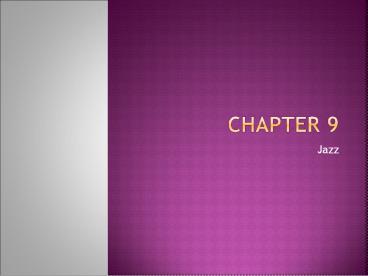Jazz - PowerPoint PPT Presentation
Title:
Jazz
Description:
Jazz Shortly after the War of 1812 From New Orleans, LA Instruments included trumpets, trombones, clarinets, saxophones, and drums A mixture of traditional ethnic ... – PowerPoint PPT presentation
Number of Views:222
Avg rating:3.0/5.0
Title: Jazz
1
Chapter 9
- Jazz
2
The birth of jazz
- Shortly after the War of 1812
- From New Orleans, LA
- Instruments included trumpets, trombones,
clarinets, saxophones, and drums - A mixture of traditional ethnic music, gospel,
blues, ragtime, classical (from Creole musicians)
3
- Jazz a musical form distinguished by its
reliance on improvisation and its rhythmic
urgency - Polyrhythmic juxtaposing two or more different
rhythms - Eubie Blake, James P. Johnson, and Earl Hines set
norms on stride piano
4
Jelly Roll Morton
- Ferdinand Morton
- 1885-1941
- Perfected Dixieland Jazz
- small ensemble, one of each
- instrument, blend of
- simultaneous improvisation
- Black Bottom Stomp
5
- Break a measure or two where everyone stops
playing except the soloist - Scat singing a form of vocal improvisation on
nonsense syllables - Ella Fitzgerald - One Note Samba
- She was discovered as a 17 year old during a
singing competition at the Apollo Theater. She
was the first black woman to win a Grammy Award.
She died in 1996 in California.
6
Louis armstrong
- 1898-1991
- From New Orleans
- Trumpet, vocals
- Nicknamed Satchmo
- What A Wonderful World
7
- With style of hot jazz sizes of band expanded
- Hotter Than That Lil Hardin
8
Reaching chicago
- New style of jazz (1930s) swing the special
rhythmic character that jazz musicians give to
the music - Fletcher Henderson developed swing style and
expanded jazz ensembles to compliment the style - Brass section 3 trumpets, 2 trombones
- Reed section 3 or 4 saxes (double clarinets)
- Rhythm section drums, piano, guitar and double
bass - Henderson Stomp trading fours
9
Big band era
- Mid 1930s, music was primarily for listening, not
dancing - Benny Goodman clarinetist, Russian-Jewish
immigrant family, King of Swing, first/only
major jazz artist to have a parallel career in
classical music - Lester Young played tenor sax, ushered the
transition from clarinet to sax - 32 bar form AABA form, standard jazz form
- Bridge a connective part of a composition
10
Composers
- Duke Ellington one of the most important
American composers, wrote over 2000 pieces, It
Dont Mean a Thing sung by Ella Fitzgerald,
Cotton Tail - Chromatic incorporating tones from a musical
scale consisting entirely of half steps - Mary Lou Williams popular female composer,
Zodiac Suite (Gemini)
11
1940s and bebop
- Bebop a complex and sophisticated type of
improvised jazz, for listening rather than
dancing - Smaller ensemble than big band/swing, more
freedom to improvise
12
Bebop musicians
- John Birks Dizzy Gillespie trumpet
- Charlie Yardbird Parker alto sax
- Made melodies more chromatic, harmonies and
rhythms became more complex, rapid tempos and
dazzling technical displays - Shaw Nuff by Gillespie and Parker
13
- 1950s return to Dixieland and Ragtime styles,
developed new styles rhythm and blues and
modal jazz - Dorian Mode a scale with the pattern of WHWWWHW
- Miles Davis pioneer of modal jazz, So What
- Thelonious Monk Smoke Gets in Your Eyes
14
- 1960s/70s free jazz, similar to modal jazz,
just more complex - Miles Davis, Herbie Hancock, Chick Corea, and
Quincy Jones pushed new style of fusion
combination of jazz and rock - Birdland - fusion
- So Danco Samba - Latin
- I Got You blues
- Easy Listening Norah Jones, Kenny G































